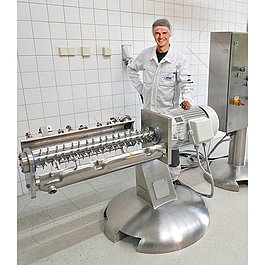Applications of particle agglomeration
Powder agglomeration is a necessary and beneficial process in many industries. In the mining industry, powdery raw materials like limestone, copper, nickel, cobalt, zinc, gold, and silver are often agglomerated prior to heap leaching.
Common examples of agglomeration in agriculture are soil and fertilizers. These materials are agglomerated to prevent segregation and improve handling characteristics.
Some glass and plastic manufacturing processes also include an intermediary stage during which powdery materials are agglomerated. The agglomerated particles are later melted down and formed into products and containers.
Plenty of consumer goods also undergo powder agglomeration during the manufacturing process. From mothballs to pharmaceutical tablets to any number of food products like bouillon cubes and hot cocoa mix, particle agglomeration is a crucial step in the creation of many of the products we have in our homes.
The RMG pin mixer from amixon® is used by manufacturers in diverse industries worldwide to agglomerate the following materials:
- Pharmaceutical tablets and vitamins
- Instant tea, coffee, and beverage powders
- Baking agents
- Sugar substitutes and cellulose derivatives
- Color pigments for food and ceramics
- Building and insulating materials
- Hot glue
- Carbon and black pigment derivatives
- Detergents and cleaning agents
- Chemicals and pesticides
- Ink and toners
- Pet food and animal feed
- Metal powders, cover powders for foundries, and sintered materials
Benefits of agglomerated powders
There are many reasons to agglomerate powders. In general, industrial agglomeration tends to improve the overall handling characteristics of bulk powders.
From a processing perspective, agglomerating raw materials is an intermediary step that can yield the following benefits:
- Eliminating dust
- Preventing segration
- Easier storage and transportation
- Improved melting, porosity, permeability, and density characteristics
- Better feeding and dispersion
- Reduced caking
- Increased flowability
- Reduced product breakdown and loss
From a consumer perspective, agglomerated products may have the following benefits over loose powders:
- Easier to dose and measure
- Improved appearance
- Dust-free
- Easier storage and handling
- Increased bulk density (more product in less space)
- Improved mouthfeel and consistency in food products
- Improved active ingredient delivery in pharmaceuticals
- Improved solubility for instant food products
Preventing agglomeration and granulation in powders
It is important to note that, in addition to being a purposeful and beneficial powder processing method, particle agglomeration and granulation can also be a natural and unwanted phenomenon.
Unwanted agglomeration can occur when powders and other bulk solids bind or to the surfaces of their containers, especially if exposed to heat or moisture. Caking, lumping, and buildup are all examples of agglomeration that is undesirable, whether during processing or in a finished, powdery product.
Unwanted particle agglomeration can be prevented via proper powder mixing and storage. Uniform pelletization or granulation can also reduce unwanted agglomeration. This is essentially the process of using controlled agglomeration to keep powdery substances from forming irregular and unsightly lumps.

